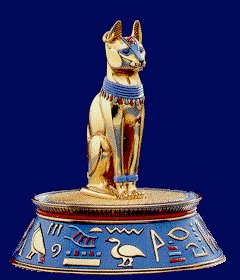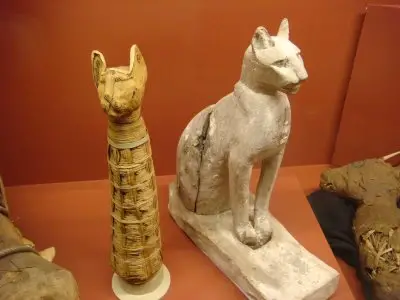After the pyramids and the Kohl painted eyes, almost nothing evokes more awe and mystery than the fascination ancient Egyptians had with cats. The ancient Egyptians believed that cats had magical powers. They believed Egyptian cats protected their homes and children from danger. They kept a cat for protection. In Egypt, from the day to day streets of Cairo, to the long lived pyramids at Giza, cats are and have always been, a big part of Egyptian culture.
Breeds of Egyptian Cats

There were two main breeds of cat native to Ancient Egypt. The jungle cat (Felis chaus) and the African wildcat (Felis silvestris lybica). The latter had a calmer temperament and so was more commonly domesticated than its wilder relative. The two species eventually merged creating a new breed which was closely related to the modern Egyptian Mau.
As the cat was domesticated, further changes in temperament and appearance became apparent. Cats became more colorful, their bodies became smaller and less muscled, their brains became smaller and they developed an increased tolerance for humans.
The cat in ancient Egypt was a sacred and respected animal. Bastet (Devouring Lady) is a sacred cat of ancient Egypt. Bast is first and foremost a protectress; specifically of the royal house and the Two Lands. Later she got the life-preserving goddess of joy and protector of women. However, Bast’s original role did not include the “cat as sex symbol” archetype. Worshiped in the Delta city of Bubastis and usually depicted as a cat or in human form with the head of a cat, Bast was seen as a protector of cats and those who cared for them.

The first feline Egyptian goddess might be Mafdet, depicted in the Pyramid texts as killing a snake with her claws. Mafdet might be translated as “runner” in Egyptian. While there are many other cat goddesses, Bast is the only one represented as a domestic cat. The lion-headed goddess Sekhmet rules over the fate of humanity.
Fact of Egyptian Cats
Cats were not only protected by almost every occupant of Egypt, but also by the law. So extreme in fact was the devoutness of the Egyptian culture to the cat, that if a human killed a feline, either intentionally or unintentionally, that human was sentenced to death. Laws were set that also forbade the exportation of cats, though more often than not, many were smuggled to the neighboring Mediterranean countries.
The cult of the cat and the goddess Bastet changed over the years and cats began to be raised for the specific purpose as offerings to the goddess. Cat mummies were sold to people and these would be left at the temple as an offering to the god. This change led to the killing of hundreds of thousands of Egyptian cats.